How’s our economy performing?
Now that’s an important question if you’re a property investor or in business. 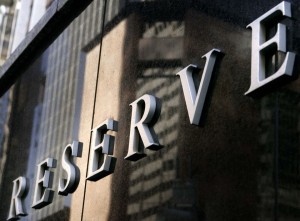
Each month the Reserve Bank meets to discuss the state of the economy and set official interest rates and then releases its minutes to explain the reasons behind their monetary policy decision and a chart pack which I summarise for you here at Property Update each month.
But before I share their latest Charts, I’d like to share some of my thoughts I recently read on how the Australian economy is faring.
I was interested to read Peter Switzer call our current phase a “crazy economy!” He suggests:
- Business is feeling good,
- consumers are too negative,
- wages aren’t rising by much,
- business investment has been low,
- interest rates are historically low,
- house prices in Middle Park Melbourne were up over 40% last year,
- the dollar is at 79 US cents when most economists thought it would be 69 US cents,
- We had one negative quarter of growth over the past 12 months but the stock market returned 14% including dividends!
Switzer blames this is crazy economy on the GFC and the expansionary policies that central banks introduced worldwide to avoid a Great Depression.
But things are picking up and business conditions are the best in almost a decade – the global economy has improved, interest rates are low, wage pressures are contained and consumers are spending so why shouldn’t business be feeling good.
This means they’re likley to soon start employing more people and that’s a good thing for our ecoonomy.
Of course any predictions for the economy could be blown out of the water (literally) if the tensions between North Korea and the USA escalate.
So let’s see what the RBA Charts show:
INTERNATIONAL ECONOMIC GROWTH
Of course Australia doesn’t operate in a vacuum, so it’s important to start with the international context…
The slew of numbers across various major economies continue to suggest a mixed picture, but overall global economic conditions have picked up since the middle of 2016 and appear to be stronger in the first half of 2017 than they have been in recent years.
Conditions in the global economy are continuing to improve.
Labour markets have tightened further and above-trend growth is expected in a number of advanced economies, although uncertainties remain. 
Growth in the Chinese economy has picked up a little and is being supported by increased spending on infrastructure and property construction, with the high level of debt continuing to present a medium-term risk.
The economic growth of our major trading partners is forecast to be around its long-run average this year before easing slightly in 2018, even though growth in China is a little uncertain.
The International Monetary Fund expects global economic growth of 3.5 per cent in 2017 and 3.6 per cent in 2018, compared with 3.2 per cent growth in 2016.
However, the IMF has identified a number of potential risks to the global economy, including inflated asset prices, a growing trend toward protectionism and the outlook for the Chinese economy.
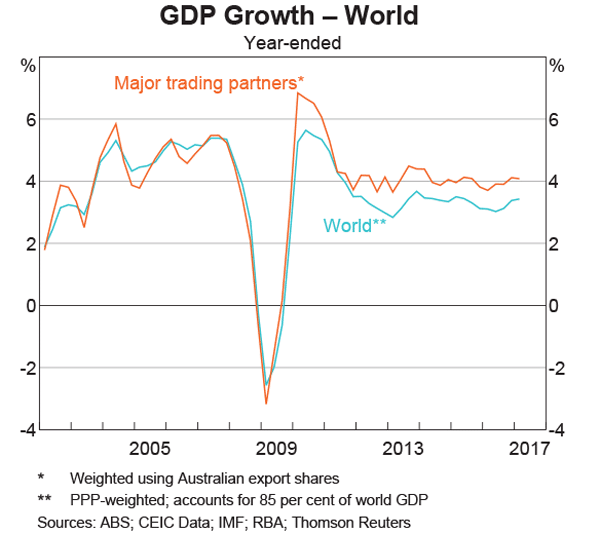
INFLATION
Headline inflation rates have declined recently, largely reflecting the earlier decline in oil prices.
EMPLOYMENT
Unemployment is falling in the 3 biggest economic regions, meaning their economies are slowly improving:

While many of the previous concerns of a world recession have faded, we’re in a low growth, low inflationary, low interest rate environment which is likley to remain that way for some time.
Most central banks have been trying to stimulate their individual economies with low interest rates, but in general this has been to no avail.
Of course it’s much the same in Australia – our low interest rates are not stimulating the economy as much as the RBA would like – hence my earlier suggestion that I can’t see a rate rise any time soon.
Having said that, a conflict between the USA and North Korea, or a trade embargo by the USA placed on China because of it’s stance on this conflict could play havoc with the major economies.
AUSTRALIA’S ECONOMY
There has been a noticeable slowing in Australian growth momentum over the past few months – our economy is fragile.
Annual growth is currently around 1.7 per cent, which is well below the long term averages, more in line with the lower growth environment the rest of the developed world has experienced since the GFC.
However the RBA’s forecasts for the Australian economy are largely unchanged.
Over the next couple of years, the central forecast is for the economy to grow at an annual rate of around 3 per cent. 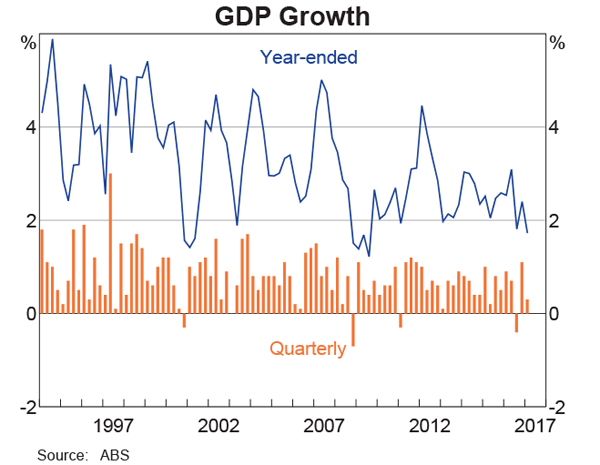
Economic conditions continue to vary across the states.
Recently, economic growth has been strongest in Victoria, New South Wales and ACT and weakest in Western Australia.

And like the rest of the world, Australia is in a low inflationary environment which is of course one of the reasons the RBA can keep official interest rates so low.
The inflation rate edged lower in the first half of this year with consumer prices in Australia rising only 1.9 percent through the year to the June 2017.
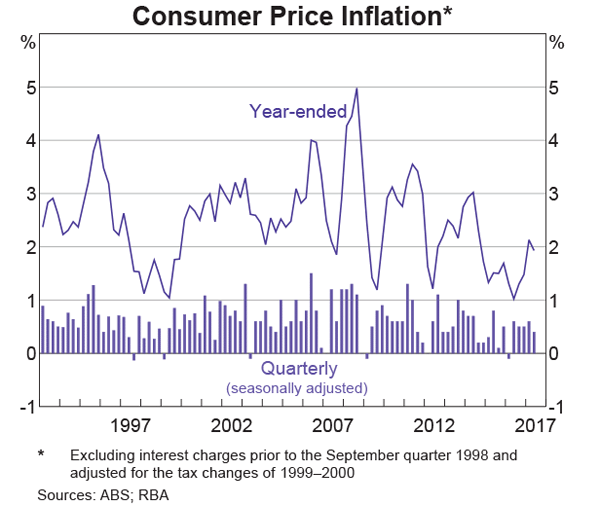
HOUSEHOLD SECTOR
The sluggish household sector is a concern.
Retail sales have picked up recently, but slow growth in real wages and high levels of household debt are likely to constrain growth in spending.
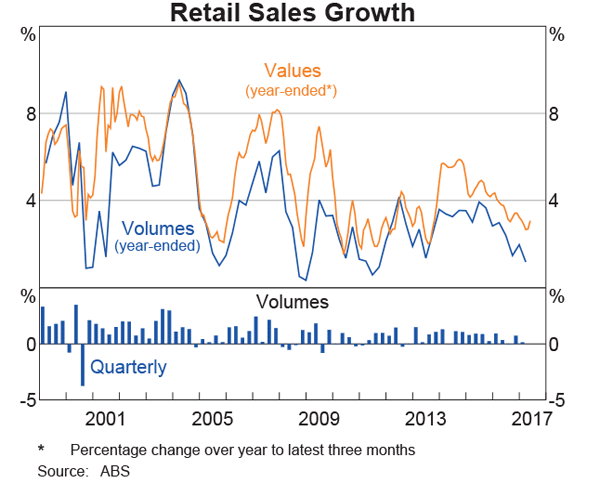
However household income growth has remained weak, and there has been a further decline in the household saving ratio.
Low growth in household disposable income continues to weigh on spending.
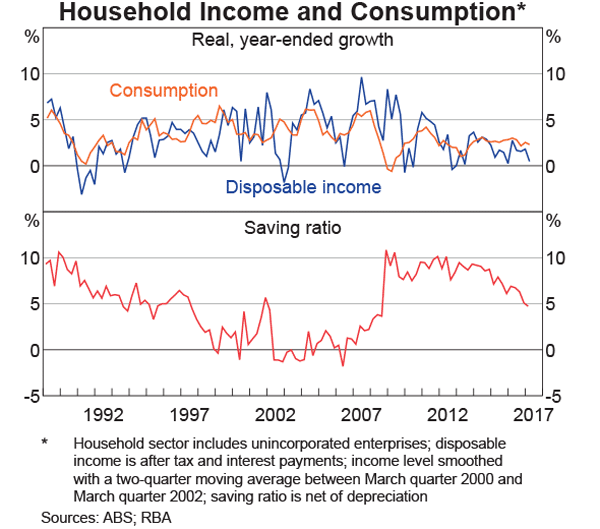
Having said that Australian households are amongst the wealthiest in the world, with our assets (primarily in real estate) increasing in value faster than our liabilities 9due to low interest rates).
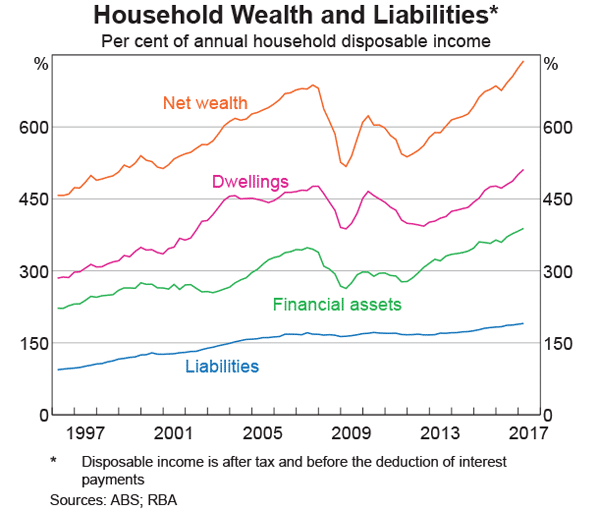
The graph below shows the interesting effect of our current low interest rate environment.
Despite record high levels of household debt, falling interest rates means that this debt is more affordable than ever with average household debt as a percentage of disposable income being at an affordable level.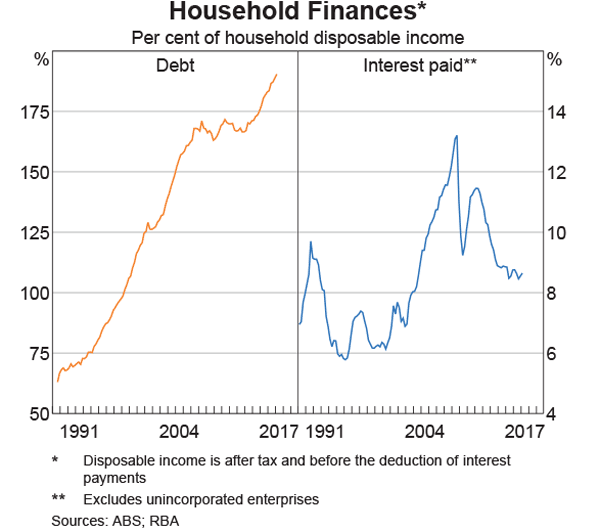
However consumer sentiment remains fickle, and currently more people are pessimist about their future than people who are optimistic.
When people don’t feel confident about their jobs or their future, they don’t spend.
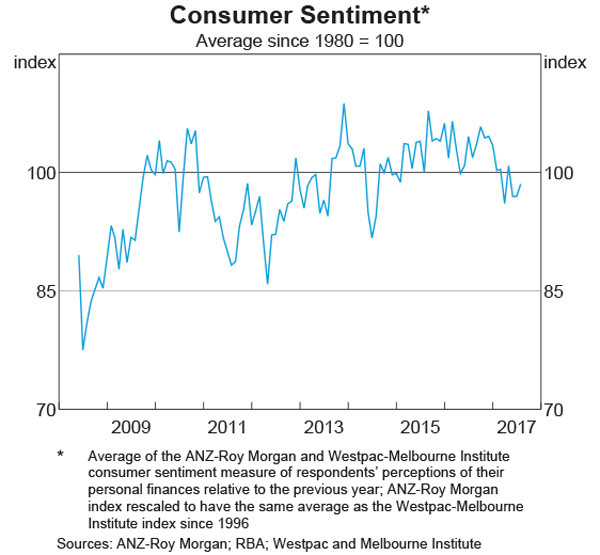
OUR HOUSING MARKETS
Conditions in the property markets vary considerably around the country.
Housing prices have been rising briskly in some markets (Melbourne, Sydney and Canberra) although there are some signs that these conditions are starting to ease.
In other markets, prices are declining. 
- In the eastern capital cities, a considerable additional supply of apartments is scheduled to come on stream over the next couple of years.
- Rent increases remain low in most cities.
- Investors in residential property are facing higher interest rates.
- There has also been some tightening of credit conditions following recent supervisory measures to address the risks associated with high and rising levels of household indebtedness.
- Growth in housing debt has been outpacing the slow growth in household incomes.
The decline in higher-density approvals has been concentrated in New South Wales (where housing activity has been quite strong of late) and Queensland (where conditions have been less favourable.)
This is a good thing as supply of new apartments is currently running ahead of demand, particularly in the Melbourne and Brisbane CBD’s.
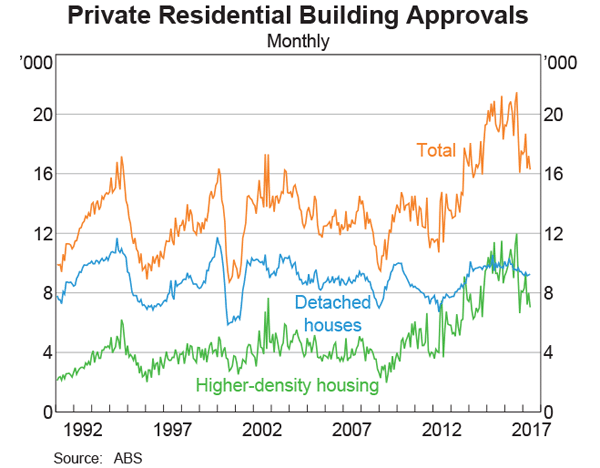
OUR PROPERTY MARKETS ARE TAKING A BREATHER
The scorecard is in for the first seven months of the year and our property markets slipped down a gear according to Corelogic, gradually responding to higher mortgage rates, tighter credit policies and affordability challenges.
The latest results highlight the diversity of housing market conditions.
Most capital cities recorded a rise, however, a 3.1% gain in Melbourne was a significant driver for the strong monthly result across the combined capitals. 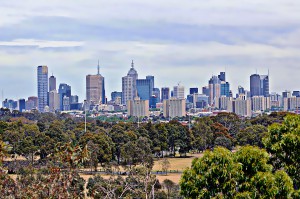
- Combined capital city dwelling values increased by 1.5% in July 2017 with values increasing across all capital cities except Brisbane, Perth and Darwin.
- Over the three months to July 2017, capital city dwelling values increased by 2.2% with values increasing in Sydney, Melbourne, Adelaide and Canberra but falling elsewhere.
- Dwelling values have increased by 10.5% over the past 12 months with values increasing by more than 10% over the year in Sydney, Melbourne and Canberra.
- Dwelling values have continued to fall over the past year in Perth and Darwin.

Housing finance and credit data confirm investor interest in the housing market has started to drop off.
Affected largely by Australian mortgage lenders rationing credit to the investor segment, the lifting of mortgage rates is also starting to bite .
It remains to be seen if this slowdown lasts or, if once the rationing of credit eases, the investor segment of the market returns to residential property.
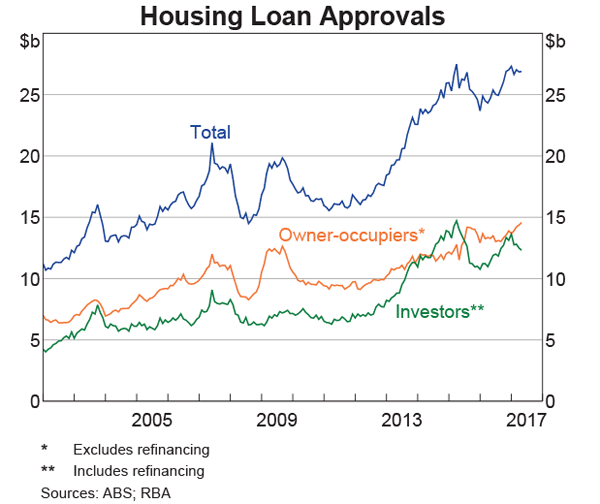
TWO OF THE MAJOR DRIVERS FOR OUR HOUSING MARKETS:
Our housing markets are very dependent on consumer confidence.
There is a direct link between consumer confidence and housing turnover and rising prices.
- Consumer sentiment has fluctuated widely recently, and currently more of us have become pessimistic.

2. Employment growth has been stronger over recent months, and has increased in all states.
The various forward-looking indicators point to continued growth in employment over the period ahead.
The unemployment rate is expected to decline a little over the next couple of years.
Against this, however, wage growth remains low and this is likely to continue for a while yet.
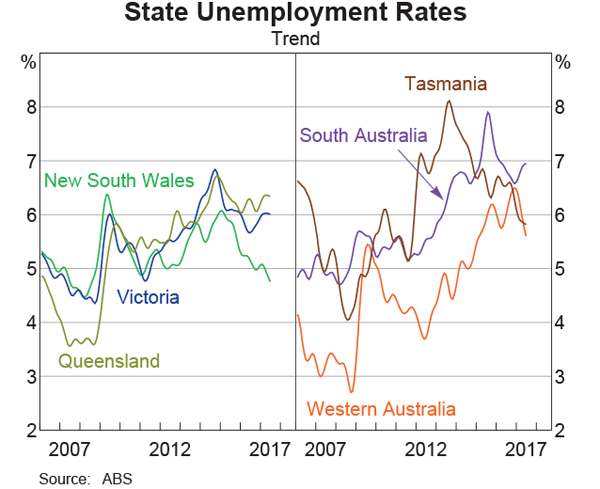
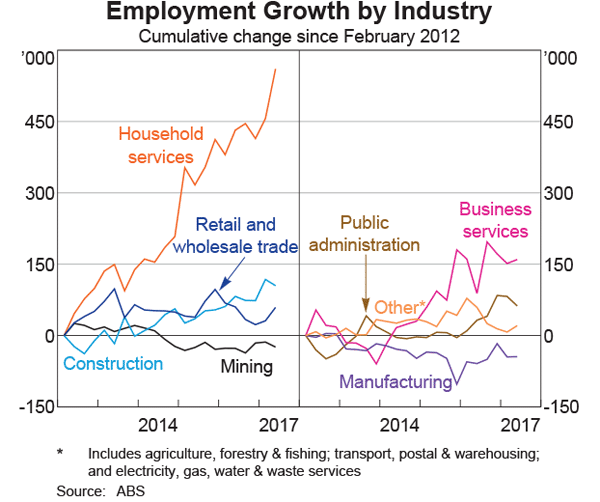
THE BOTTOM LINE:
All in all, our economy is sound and we’re now in a period of low economic growth with low inflation, low wages growth and low interest rates.
By the way…the rest of the world has been operating in this environment since the GFC
We were sheltered from this by an extraordinary mining boom and our economy’s resilience to transition from this has been surprisingly impressive.
Of course there are still risks out there…
Which means the RBA is unlikely to increase interest rates for a while but the banks, under pressure from APRA, are raising their rates and at the same time causing a “credit squeeze” in an attempt to slow down the Melbourne and Sydney property markets.
This means as property investors for the foreseeable future we can’t expect the type of strong capital growth in property prices we experienced recently.
By the way…this doesn’t mean it’s the wrong time to invest in property.
What it does mean is that careful property selection is critical as you can’t count on the market to do the heavy lifting.
It also means a more stable property environment without the booms and busts.
WHAT DOES THIS MEAN FOR YOU?
Clearly owning property – your own home and investment properties is the way to wealth in Australia
If you’re looking for independent advice about property no one can help you quite like the independent property investment strategists at Metropole.
Remember the multi award winning team of property investment strategists at Metropole have no properties to sell, so their advice is unbiased.
Whether you are home buyer or a beginner or a seasoned property investor, we would love to help you formulate an investment strategy or do a review of your existing portfolio, and help you take your property investment to the next level.
Please click here to organise a time for a chat. Or call us on 1300 20 30 30.
When you attend our offices in Melbourne, Sydney or Brisbane you will receive a free copy of my latest 2 x DVD program Building Wealth through Property Investment in the new Economy valued at $49.
from Property UpdateProperty Update https://propertyupdate.com.au/hows-our-economy-going-august-rba-chart-pack/
![[Imported] WP Advertize it Free Strategy ad 10 July 2014 (Desktop #44800)](https://propertyupdate.com.au/wp-content/uploads/2014/07/m-propertyinvestors-18July2014.png)
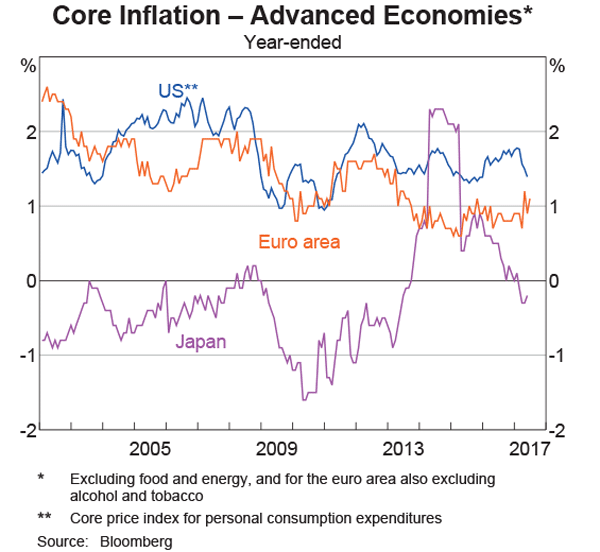

No comments:
Post a Comment